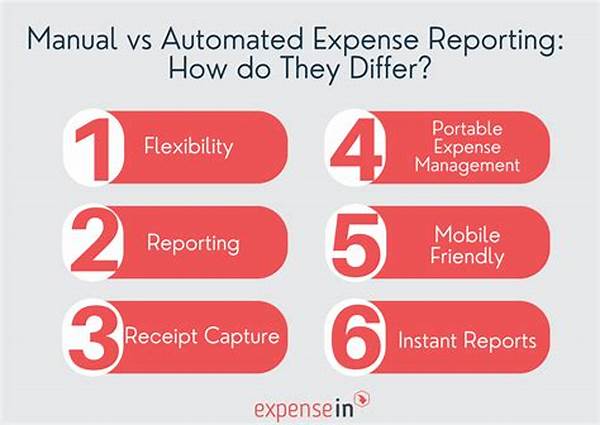Managing company expenses effectively is a critical component of business administration. In today’s fast-paced business environment, automated expense reporting tools have emerged as a pivotal solution to enhance the efficiency and accuracy of financial processes. These tools not only streamline the traditionally cumbersome task of handling expenses but also integrate seamlessly with existing financial systems, fostering a seamless flow of financial data.
Read Now : “engagement In Experiential Learning”
The Importance of Automated Expense Reporting Tools
Automated expense reporting tools are indispensable in contemporary business settings due to their multifaceted advantages. Firstly, these tools significantly reduce the time and effort employees spend on compiling and submitting expense reports. By automating data entry and leveraging optical character recognition (OCR) technology, employees can quickly capture receipts and other relevant documentation, allowing them to focus on core business activities. Secondly, automated expense reporting tools enhance the accuracy of financial information by minimizing human error. The integration of real-time auditing features ensures that expenses align with corporate policies and compliance requirements before approval. Lastly, these tools provide valuable insights through advanced data analytics. By aggregating expense data, organizations can identify spending patterns, enabling them to optimize budget allocation and improve financial forecasting. As a result, businesses can make informed decisions that drive growth and efficiency.
Key Features of Automated Expense Reporting Tools
1. User-Friendly Interface: Automated expense reporting tools are designed with an intuitive interface that simplifies user interaction, enhancing the user experience and encouraging adoption across the organization.
2. Real-Time Data Processing: These tools facilitate instant reporting and analysis of expenses by processing data in real-time, providing managers with up-to-date information for effective decision-making.
3. Seamless Integration: The ability to integrate with existing financial systems, such as ERP and accounting software, ensures a smooth transition and consistency across various business processes.
4. Policy Compliance Checks: Built-in compliance features automatically check for policy adherence, ensuring that all submitted expenses meet company standards and reducing manual oversight.
5. Data Analytics and Reporting: Advanced analytics capabilities enable the generation of comprehensive reports, providing insights into spending trends and facilitating strategic financial planning.
Read Now : Enhancing Employee Performance Metrics.
Benefits of Automated Expense Reporting Tools
The deployment of automated expense reporting tools within an organization yields numerous benefits. Primarily, these tools drive operational efficiency by automating mundane administrative tasks such as data entry and receipt verification. As a result, employees can redirect their efforts toward more strategic initiatives, enhancing overall productivity within the organization. Moreover, the risk of errors in manual data handling is substantially mitigated, ensuring the reliability and integrity of financial records. Additionally, automated expense reporting tools offer scalability to accommodate the evolving needs of growing enterprises, allowing for the seamless addition of users and transactions without compromising performance or accuracy. These advantages collectively contribute to a robust financial framework, empowering organizations to achieve their financial objectives with precision.
Challenges in Implementing Automated Expense Reporting Tools
Despite their myriad benefits, organizations may encounter challenges when implementing automated expense reporting tools. One such challenge is the initial setup and customization process, which can be time-consuming and requires investment in training personnel. Additionally, ensuring compatibility between the new tools and existing financial systems is crucial to avoid data synchronization issues. Resistance to change among employees accustomed to traditional methods may pose another hurdle, necessitating comprehensive change management strategies. Furthermore, safeguarding sensitive financial information from cyber threats is imperative, requiring robust security protocols and regular vulnerability assessments. Addressing these challenges diligently is essential for organizations to fully realize the potential of automated expense reporting tools.
Overcoming Common Barriers to Adoption
Many organizations face barriers when adopting automated expense reporting tools. A primary barrier is the perceived complexity of these systems. Overcoming this requires clear communication on the benefits and ease of use of such tools. Comprehensive training sessions and workshops can aid employees in understanding and navigating the new system efficiently. Additionally, integrating feedback from users can help to tailor the system to better meet organizational needs. It is also vital to manage expectations and provide continuous support during the transition phase. Another barrier is financial investment. While initial costs may seem high, the long-term savings and efficiency gains provided by automated expense reporting tools justify the expenditure.
Summary of Automated Expense Reporting Tools
In summary, automated expense reporting tools serve as a transformative solution for modern businesses, offering streamlined processes, enhanced accuracy, and comprehensive insights into financial activities. These tools enable employees to manage expenses efficiently while ensuring compliance with corporate policies. Despite potential challenges such as integration complexities and user resistance, the benefits of adopting these tools—including reduced operational costs and improved financial oversight—are substantial. By investing in automated expense reporting tools, organizations can elevate their financial management practices, positioning themselves for sustained success in today’s dynamic business landscape. As businesses continue to evolve, the role of automated expense reporting tools in driving organizational efficiency and growth becomes increasingly significant.
